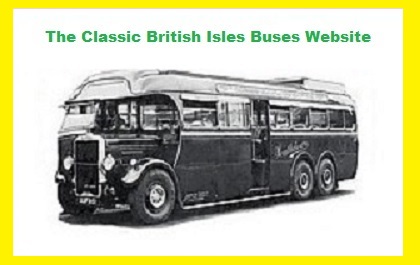

The Classic British Isles Buses Website
Classic buses in Australia, page 2 (by Dick Gilbert)
Last updated 27 August 2024
Email Events diary Past events list Classified adverts Classic U.K. Buses Classic Irish Buses Classic Manx Buses
| Page 1 | Page 2 | Page 3 | Leyland OPS4 Tigers |
These pages form a scrapbook of material about British buses in Australia.
Please feel free to send any suitable items and I will be happy to post them.
THE SYDNEY BUS MUSEUM IS BACK! (UPDATE)
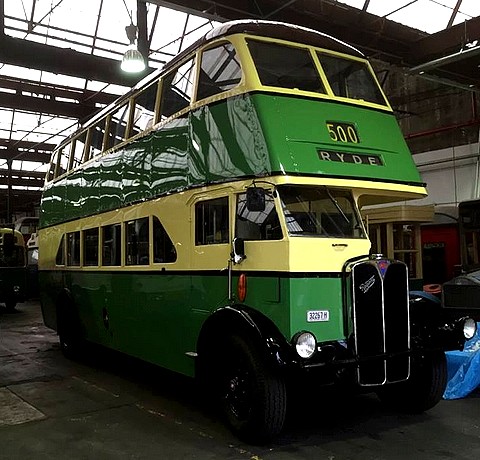
Sydney AEC Regent 2338, freshly restored just in time for the opening of the new Museum premises.
The Sydney Bus Museum was formed in 1986 at Tempe in south Sydney, but in 2010 the premises became a working bus depot and the Museum needed to move. That process has been huge, and only now is the splendid new facility at Leichhardt, about 3 miles west of the city centre, able to open. A special preview day for invited guests took place just before Christmas 2015 and the official opening day was on 1 August 2016, after which it opened to the public on the first and third Sunday of each month. It is hoped that the frequency of open days can be increased over time. So at last visitors can once again see the Museum's superb collection, including Sydney Regent 2338 seen above, which has just undergone a painstaking total restoration by the team. Many thanks to Garth Wyver (one of that team) for sending me the photo and the info.
A COUPLE OF PICTURES FROM NEW SOUTH WALES
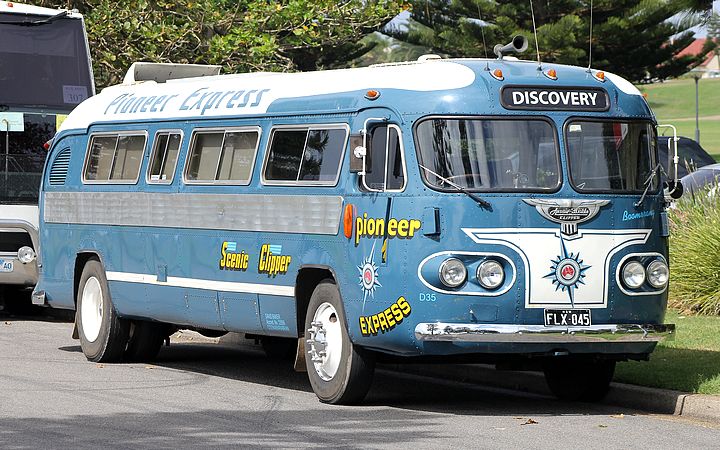
John Townsend went out to Australia early in 2015 and kindly brought back a pair of photos for the Classic Buses Website. The picture above shows Flxible Clipper FLX.045 in the livery of Pioneer Express which John spotted along the front at Newcastle NSW. There are quite a few Clippers in the country, and even a Flxible Clipper Club of Australia but we've never featured one on this website, so thanks to John for the chance to put that right.
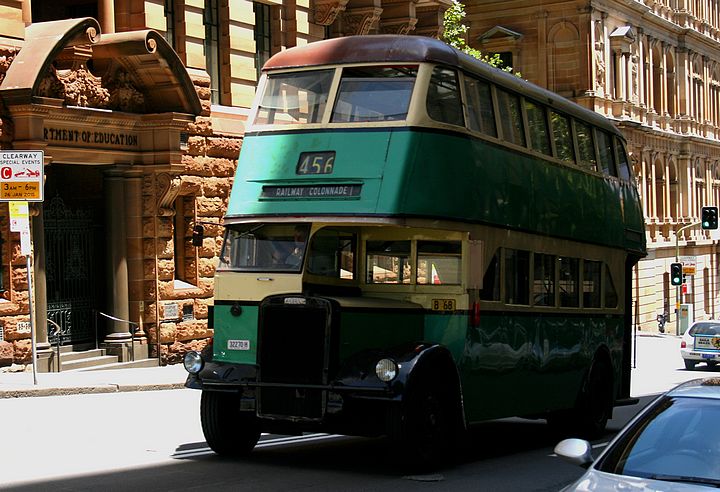
John's second picture shows New South Wales Leyland Titan no. 2186 climbing up Bridge Street, Sydney. Built in 1949, it is now part of the Sydney Bus Museum collection. Thanks very much to John for sending the pictures.
THIS REGAL IS (PROBABLY) UNIQUE
In September 2014 I was sent this picture of an AEC Regal in New South Wales, and it could be the only one of its breed.
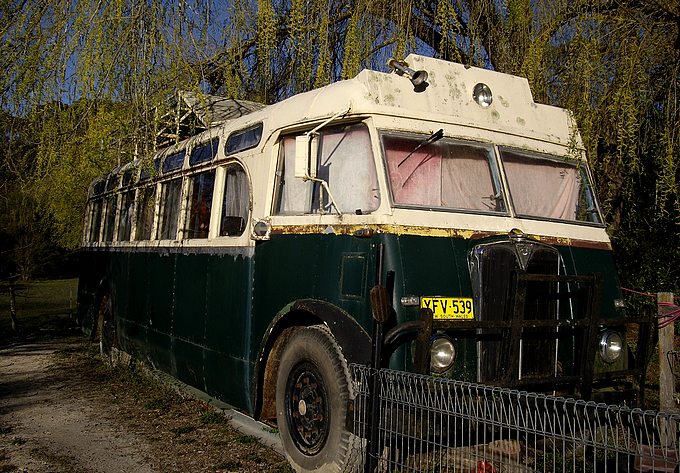
Garth was a volunteer at the Sydney Bus Museum (now moved to new premises at Leichhardt, about 3 miles west of the city centre). He kindly kept me advised of news from the collection, but this vehicle was actually spotted at Blackheath NSW, about 50 miles north west of Sydney, and just a short bush walk from Garth's home.
Clearly an AEC Regal, its proof of identity was revealed when Garth chatted up the owner and got inside the vehicle (now a mobile home up on blocks), which has the number 2535 painted in the cab, along with a ComEng body plate dated 1951. This establishes that it is one of fifty Regal III buses delivered to the Department of Road Transport and Tramways, Sydney in 1951, numbered 2521-2537, 2539-2550 and 2561-2580. There was a similar batch of 18 built in 1954/55 on AEC Regent III chassis.
Apparently the bus was at Kurragong before coming to the Blue Mountains. It will run, but has a leaking radiator and brake problems. Although one of the 1955 Regent III single deckers survives (no. 2878 at the Sydney Bus Museum) I believe that Garth discovered here the only remaining example of the 50 Regals (unless you know better?). This surely has to be a preservation candidate! Sadly Garth passed away in 2020.
THE STORAGE YARD AT WHITEMAN PARK
Here's an intriguing picture from Australia. How can you resist walking over to take a look at this lot? It was sent to me by regular contributor Nicholas Pusenjak and shows the storage yard at Whiteman Park, Perth, home of the Bus Preservation Society of Western Australia.

Nicholas said; "The Bus Preservation Society of Western Australia has a severe lack of storage for its collection. This panoramic view of buses in external storage taken by Colin Davison shows buses held for future restoration or as spare parts donors. These are all outside of the area leased by the Society. Whiteman Park administration is comfortable with nine buses held outside, but not as many as we have. The Society needs more space, particularly covered accommodation and volunteers to restore and maintain the collection."
Left to right they are:
AEC Regal III (1948) - spare parts donor, retained as a rolling shell display. Ex WAGR A14.
Bedford SB (1952) - restoration project. Ex Carlisle Bus Service 6 and MTT 185.
AEC Regal IV 9823E - restoration project.
Leyland Panther - spare parts.
AEC Regal VI - spare parts.
Foden PVSC - spare parts.
Guy Arab III (1950) - spare parts. Ex WAGT 99 and MTT 323.
Guy Victory Airide WUM Scenicruiser (1961) - spare parts. Ex WAGR G63.
AEC Regal III (1952) - spare parts. Ex Fremantle 22 and MTT 228.
2 x Guy Victory Airide WUM Scenicruiser (1961) - rolling shells (Ex WAGR G58 and G60), one to be restored out of three.
Mercedes-Benz O305G articulated bus (1979) - spare parts. Ex Transperth 470.
Not visible are two Dennis Lancet IV J7, a Daimler CVG5 and an AEC Regal VI.
That's a mouth-watering sight. Thanks to Nicholas for sending the image and information.
Postscript: Sadly Nick Pusenjak passed away suddenly in May 2017. He had been sending me photos and comments from Australia for years and was an amazing source of information about Australian buses and other old transport matters. His contributions can be found all over this website, and will remain there for ever as my tribute to a fine fellow who is sadly missed.
A 1927 LEYLAND LION IS RESCUED
The Lincolnshire Vintage Vehicle Society first drew my attention to this great discovery. It's a 1927 Leyland PLSC1 Lion.
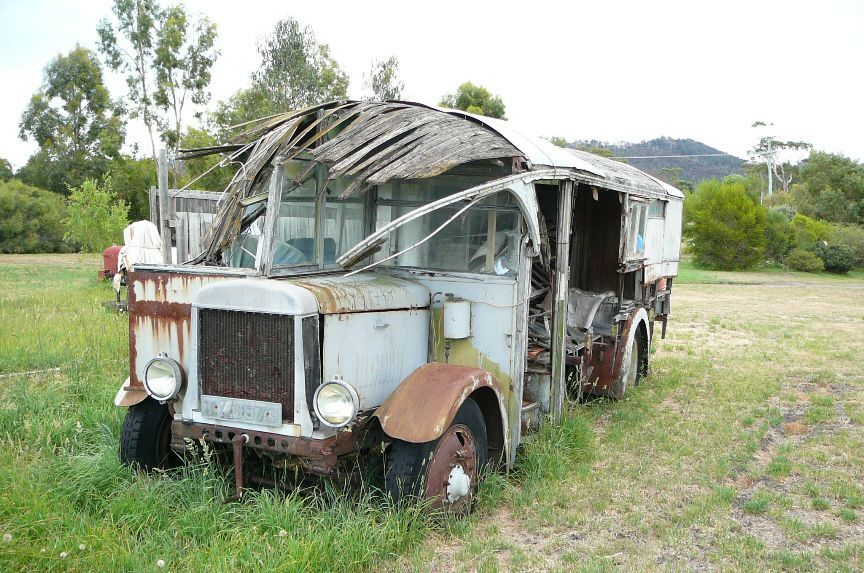
TY 3673 (chassis number 46035) was new in September 1927 to Amos Proud of Choppington, Northumberland, with a Leyland B31F body. It was acquired by United Automobile in 1928 as no. B282, and then to Lincolnshire Road Car in 1931, for whom it worked out of Boston, Lincs as no. 132. Exported in the 1950s it became a caravan, and wound up in Tasmania.
Then, in October 2013, I received this email from Peter and Helen Berry of Dandenong North, Melbourne:
"Thanks to the guys from the LVVS, my wife Helen negotiated the purchase of this bus in 2012, as a restoration project for us. We moved the bus on a flat bed truck in March 2013 from Tasmania to Melbourne. We modified our carport area and built a garage to restore the bus in at our house."
"TY 3673 was one of the Lions that was heavily rebuilt in 1946 and was finally retired from service in June 1951. As far as we know, the bus was purchased direct from Lincolnshire in the latter part of 1951 by a Mr. Rose who then shipped the bus to Hobart, Tasmania. It was driven 12 miles from the Hobart docks to Cambridge where it was converted into living quarters for himself, his wife and four children. They lived in the bus while Mr. Rose built a house on a newly acquired block."
"The bus was never registered in Tasmania and the gradual decline of the bodywork set in after a couple of years once they moved into the house. In 1986 The family moved away and the bus was offered to the Tasmanian Transport Museum who declined it because it had no local historical significance. But the curator of the museum knew of a fellow founder member who had been chasing the bus for years and, once contact was made with Mr. Rose, he had four days to move it, before it went for scrap."
"It was transported in 1986 to the new owner's house and there it stayed until we purchased it. There is no explanation for moving an old bus half way round the world just to live in it for two years. All we can think of is that Mr. Rose (now dead) must have had shipping connections and possibly got it shipped for next to nothing. In 1951 there were no old buses for sale in Tasmania but a tram body from Hobart could have been picked up quite cheaply, as many were."
"The bus has not run since 1951 but is 100% mechanically complete. The intention is to restore to working order the chassis by 2015 and rebuild the body by 2017, in time for its 90th birthday. It was never operated in Australia as a bus so will be restored to a 1930s condition with its Leyland-built front entrance 31-seat body as Lincolnshire Road Car Co. number 132. We will be working closely with the LVVS who have been extremely helpful and supportive of this project. We are quite happy to keep you updated with progress on the restoration."
Great news! My thanks to Peter and Helen for letting me know, and here's another update from April 2021: "Progress on our Lion: all chassis components are overhauled, the motor is stripped down and we have just heard that the cracks in thecrankshaft are repairable which is good news. We have just extended our shed which gives us more room for the restoration. We have yet to rebuild the radiator but are on track for a running chassis by the end of the year. Then the fun starts. We have decided to restore it with the C W Cawood body of 1946, this will make a welcome change to all those Leyland bodies around. It will also make it the only known Cawood body in existence. So with our Lion we will have the only Amos Proud bus to survive, the oldest surviving United bus and the oldest surviving LRCC bus."
A COOGEE-SPEARWOOD RELIC TURNS UP
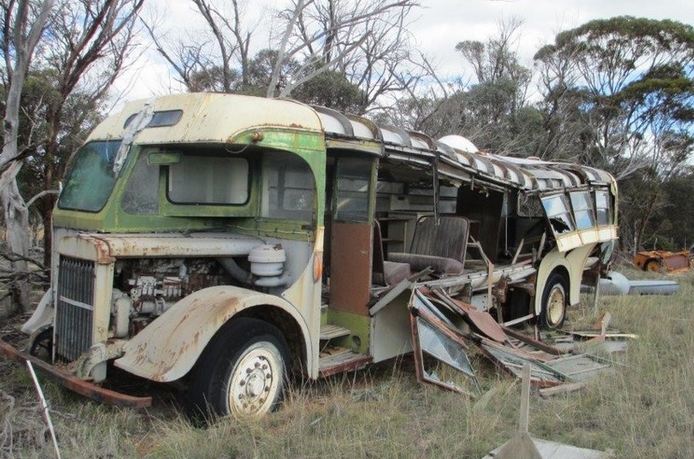
It was thought that there were no survivors from the fleet of Coogee-Spearwood Bus Co., but this Guy Arab has been discovered, and donated to the Bus Preservation Society of Western Australia in 2013. As you can see, it's in a bit of a state, but its rarity makes it a significant find.
The Coogee-Spearwood Omnibus Service, based in South Fremantle, was formed by Beryl and Eric Nicholls in 1934 from Amos Heal's Silver Lining Motor Service and John Jennings' Spearwood Bus Service.
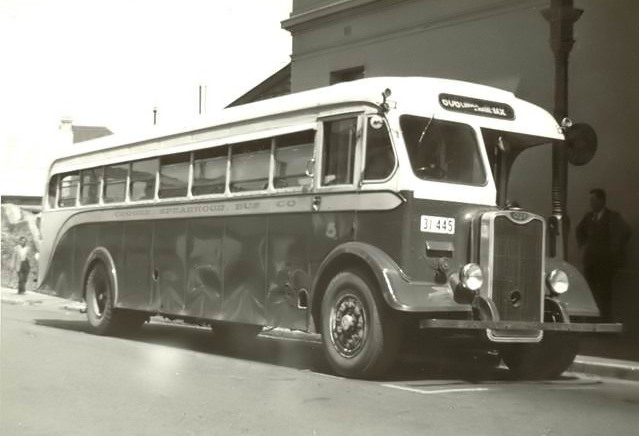
Coogee-Spearwood Guy Arab no. 5 in Collie Street, Fremantle around 1951. Photo: Howard Cowell via BPSWA.
Promising development in the area, including road improvements and the provision of electricity to the communities, inspired B and E Nicholls to invest in the business, but it didn't live up to expectations and the business was put up for sale in 1938. Metro showed interest, but didn't buy it. The fleet during this period included products from Leyland, Brockway, Mercedes and White. From the 1940s they bought a Ford V8 and four Daimler CVG5 single deckers (numbered 1-4). In the 1950s they added two Guy Arabs (numbers 5 and 6), two Fodens (7 and 8), a Regal III (No.9) and apparently a Bedford SB.
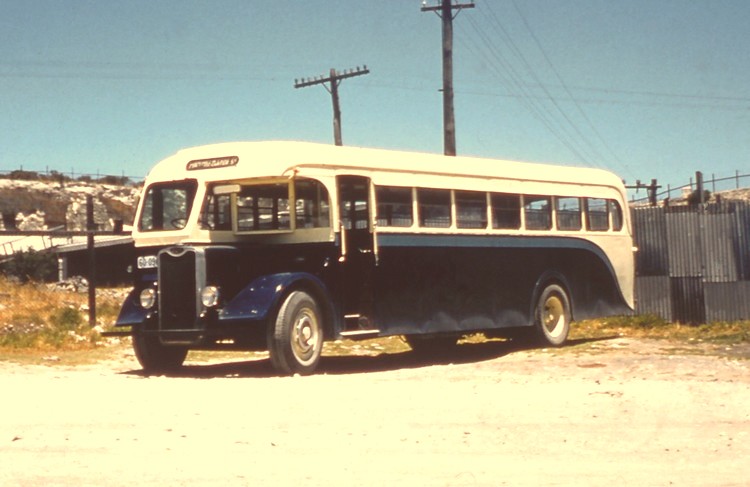
A rare colour picture of Coogee-Spearwood no. 5 in service. Photo: via Nicholas Pusenjak.
Nicholls offered the business to Metro again in 1948 and 1952, but still without success. A 1955 scheme whereby Metro would sell their Armadale operation to the W. A. Government Tramways, enabling Metro to concentrate on the western and southern regions (and to acquire Coogee-Spearwood as part of the consolidation) nearly worked, but the Government declined. In 1956 the company was restructured as the Coogee-Spearwood Buses Pty. Ltd and this firm was eventually acquired by Metropolitan Perth Passenger Transport Trust (MTT) in 1961.
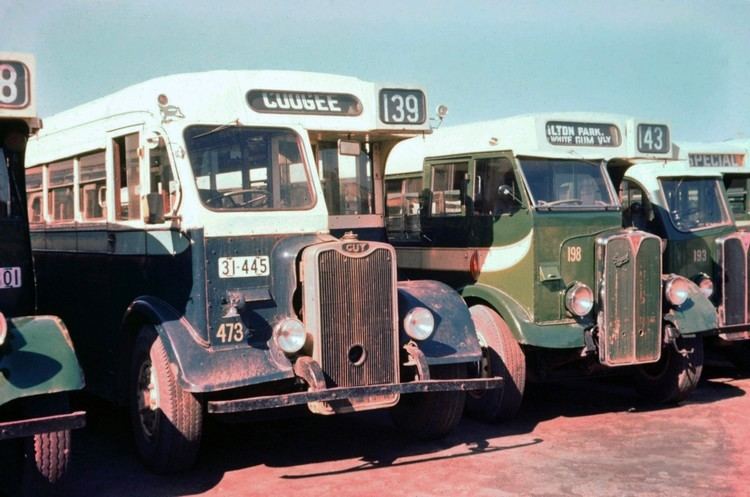
Ex Coogee-Spearwood Guy Arab no. 5 immediately after acquisition by MTT, becoming their no. 473. The Regals alongside had just been taken over by MTT from Fremantle Municipal Tramways. Photo by Jim Bond, from the David Urquhart collection, via BPSWA.
MTT inherited the four Daimlers, the two Guy Arabs, the two Fodens and the Regal III, and their assessment was that the whole lot were in a pretty poor condition. Guy no. 6 survived in MTT service until 1967 and the Regal until 1968. None of the ex Coogee-Spearwood buses were known to survive until no. 6 surfaced again in 2013.
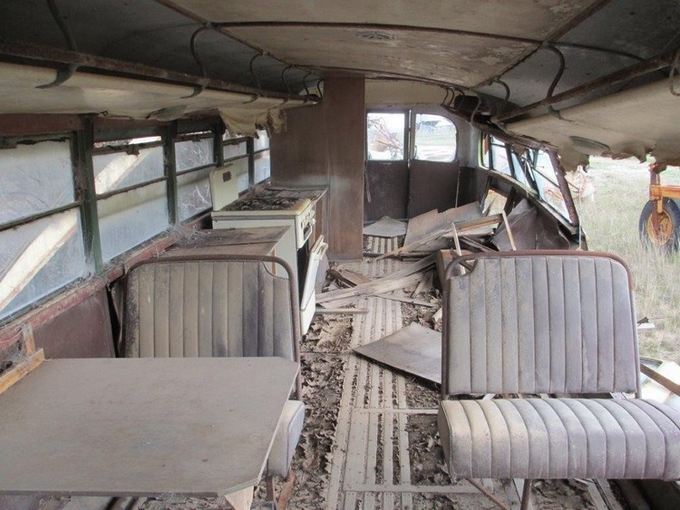
Coogee-Spearwood no. 6 was discovered on a farm in the Great Southern Region. Photo: BPSWA via Nicholas Pusenjak.
The discovery of no. 6 is quite a surprise and, having been donated to BPSWA, gives the Society an interesting challenge. An early aim of the group was to preserve at least one example from each of the operators that were taken over by MTT. So the decision now is whether to recover this essentially derelict - but unique - bus in its entirety, or use it for parts.
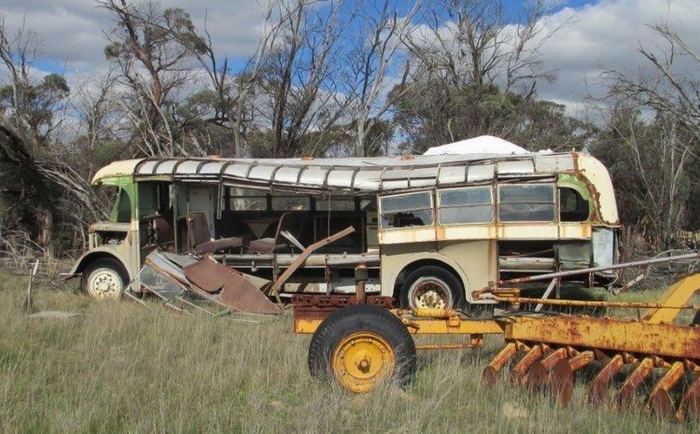
Guy Arab no. 6 would make a challenging restoration project. Photo: BPSWA via Nicholas Pusenjak.
Many thanks to Nicholas Pusenjak for his assistance with this item and provision of photographs, and specific acknowledgement to Graeme Gugeri for his fine article in the April 2011 edition of Rattler (the magazine of the Bus Preservation Society of Western Australia) which provided much of the information.
Postscript; Sadly Nick Pusenjak passed away suddenly in May 2017. He had been sending me photos and comments from Australia for years and was an amazing source of information about Australian buses and other old transport matters. His contributions can be found all over this website, and will remain there for ever as my tribute to a fine fellow who is sadly missed.
IT'S RAINING REGALS IN PERTH
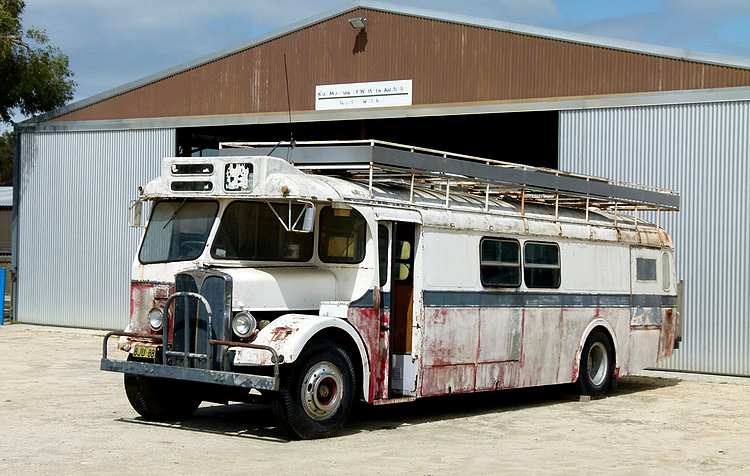
Nicholas Pusenjak kindly sent me some more great images in connection with recent arrivals at the Bus Preservation Society of Western Australia. Above is a Regal III that started life as Fremantle Tramways no. 22, one of a batch of five delivered in 1952 with Boltons metal-framed bodies (see the image below of similar 25 in service).
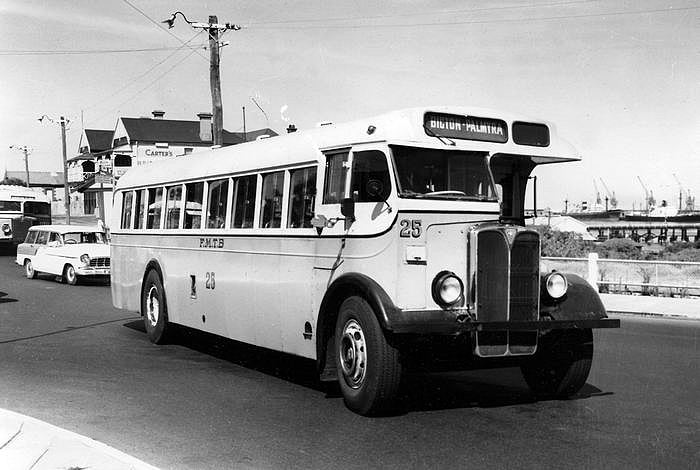
After being acquired by MTT in 1960 the body was almost entirely rebuilt, and the bus was based mostly at Redcliffe. Finally withdrawn in 1976 it passed to Cliffs Robe River Mining for use at their facilities in the Pilbara area. It then became a mobile home and toured around Australia before coming to rest in a back yard in Victoria Park, where it lay for many years.
Arriving at BPSWA's premises at Whiteman Park in September 2012, the expectation was that it would be used as a source of spares for the Association's other Regals - and that list has just grown again. Nicholas says "We have just been donated ex W. A. Government Railways A14. It was originally built with a timber-framed halfcab body and was rebodied as a full-front with fibreglass mouldings." Some previous pictures sent by Nicholas of W. A. G. R. Regals with the original and replacement bodies are on my Australian page 3 here; and here is a picture of A14 when it arrived at Whiteman Park in November.
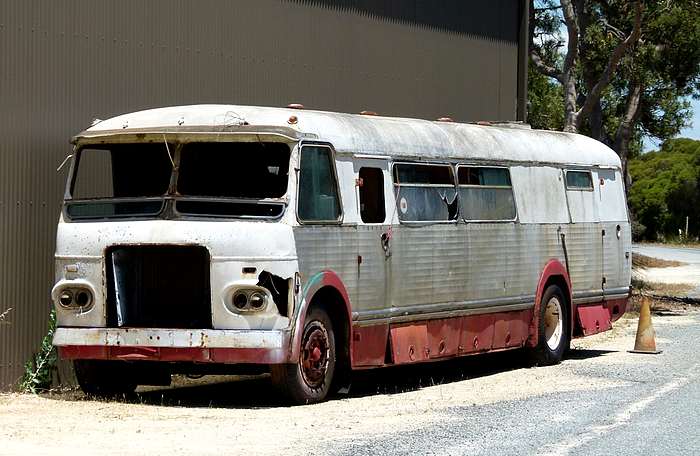
Nicholas says "I am hoping A14 may be kept intact as a static exhibit and coupled to a four wheel trailer of which we have secured the body part. It is a W. A. G. R. trailer that was hauled by three of their Regal IIIs to convey parcels and goods on several country routes. It will make a nice little static display. BPSWA has so many projects and so few people and little money that we can't restore them all to perfect operating examples but the mechanical parts from A14 and 228 should assist us to keep the other two Regal IIIs running in perpetuity."
Thanks Nicholas for the pictures and the news.
ANOTHER SYDNEY LEYLAND
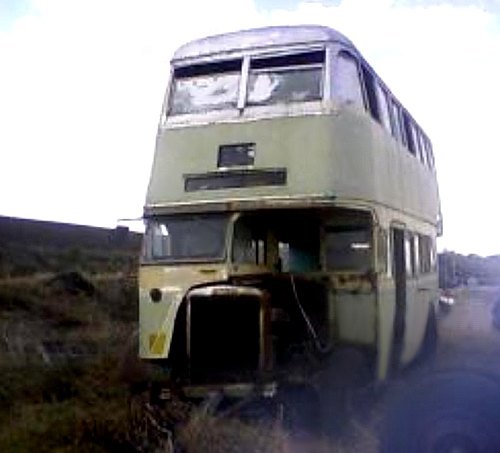
These ex Sydney double deckers keep turning up. Although photographer Michael Haug would be the first to admit that this image (taken from an old phone camera in April 2011) isn't great, it does show that yet another Sydney bus is still around. Michael says it is on a property north west of Moree, NSW, and had been converted to a site office.
The number 1771 is visible on the offside rear, which tells us that it is the ninth (and last) of the very first batch of Leyland OPD1 Titans acquired by Sydney. Delivered in 1946 with a Clyde body, it may therefore be the oldest post-war Sydney Leyland in existence - unless you know better!
This excellent list records that it was sold in 1968 to Kingswood Wreckers then resold, and later noted as a stationary caravan at Walgett NSW. Well now we know more. Many thanks to Michael for sending the photo.
MORE SYDNEY DOUBLE DECKERS RESURFACE
Mark Clayton, Arts Faculty Manager at the University of Southern Queensland, sent me these fine photos in September 2012:
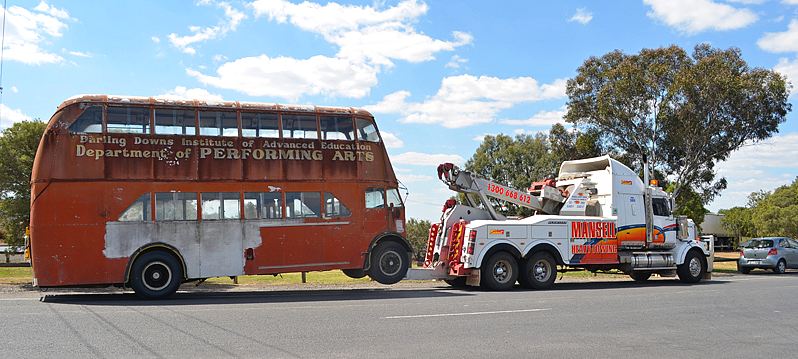
This is ex Sydney 2674, a 1952 Leyland Titan OPD2 with a Clyde body. It was sold in 1975 to the Department of Performing Arts, Darling Downs Institute of Advanced Education, Toowoomba. By 1992 it was noted in use as a toolshed at nearby Dalby.
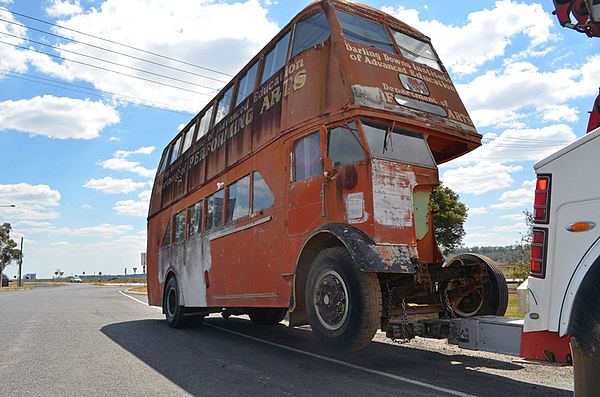
Mark now tells me that the Institute (since renamed the University of Southern Queensland) has re-acquired the OPD2 it used to own and operate. The Southern Queensland Intitute of Technology has offered to restore this vehicle on behalf of the University. The pictures show it being relocated for restoration.
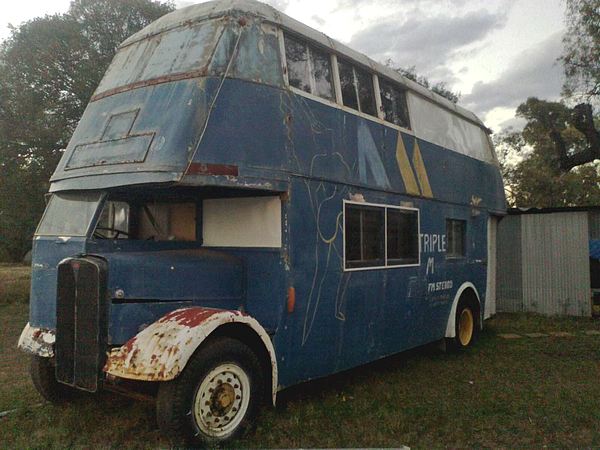
Mark also sent me this picture of what appears to be an ex Sydney AEC Regent, privately owned at Roma in western Queensland. It was clearly at one time used by a radio station as the inscription on the side reads Triple M, FM Stereo. That station still exists, and has regional bases in Sydney, Melbourne, Brisbane and Adelaide. Does anybody recognise the bus or can provide an identity?
Many thanks to Mark for the pictures.
RARE GUY VICTORY BUSES ARE RESCUED
Nicholas Pusenjak has kindly sent me the following photos and information:
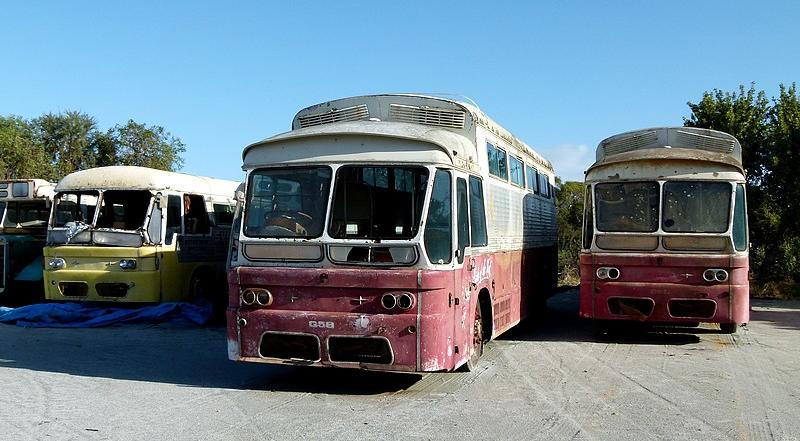
"The Bus Preservation Society of Western Australia has successfully repatriated two former Western Australian Government Railways Guy Victory 'Scenicruiser' buses to Perth for restoration of the better of the two. The buses are G58 named Pride of the West and G60 Wheatlander.
After withdrawal by the Western Australian Government Railways they were stripped of mechanical components and sold to a farmer in the Wheatbelt region for use as workers' accommodation. There they sat in a dry environment for 41 years until this May when they were brought to the Society's facility at Whiteman Park, a suburb of Perth. Sister bus G63 (the yellow one) had been acquired the previous year and will yield the mechanical parts needed. It had been used by an aerial crop sprayer and the phosphates used in the fertilisers have corroded the body to the point of no return.
The Guy Victory was a rare chassis and only seven are known to have come to Australasia, - all to the Western Australian Government Railways. We have three and the whereabouts of another is known. We don't know if any were sold to other right-hand drive export markets or the home market. Some may have been sold in left-hand drive form for use on the Continent - Belgium, Holland or Greece perhaps?" UPDATE: See here for information on a left hand drive survivor.
"The Guy Victory Airride is not to be confused with later simple and rugged front vertical-engine chassis that sold to Africa. Our buses have independent front suspension and disc brakes, and were powered by an underfloor-mounted Leyland O680 engine.
The photo above was taken at Whiteman Park shortly after the buses had been transported to Perth, and below is a page from the Guy sales brochure." Many thanks to Nicholas for that.
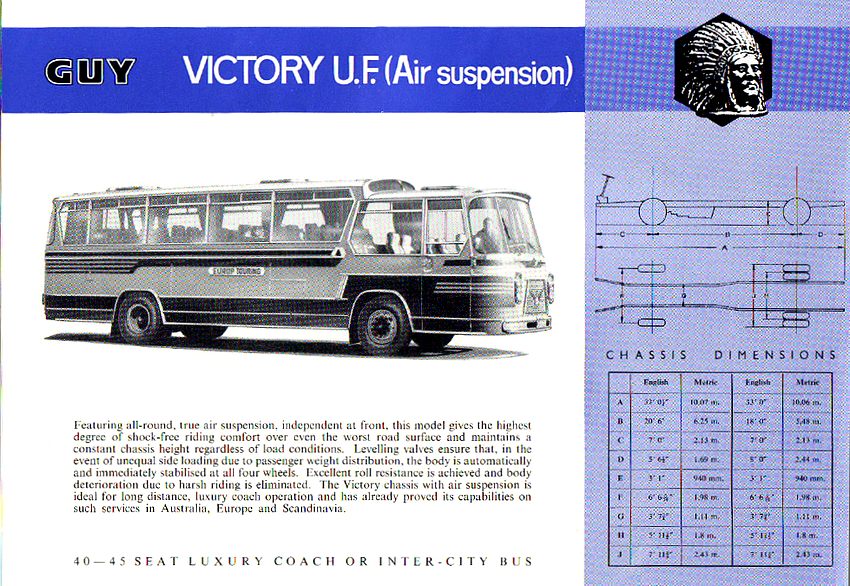
TWO MELBOURNE REGALS SPOTTED IN VICTORIA
Murray Ellwood emailed me in August 2010 to say that he recalled seeing a couple of old buses by the Hinnomunjie bridge in the vicinity of Omeo, Victoria, just east from where the Omeo Valley Road crosses the Mitta Mitta River. These appeared to be ex M and MTB buses converted to mobile homes, and Murray thought I might be interested to check it out.
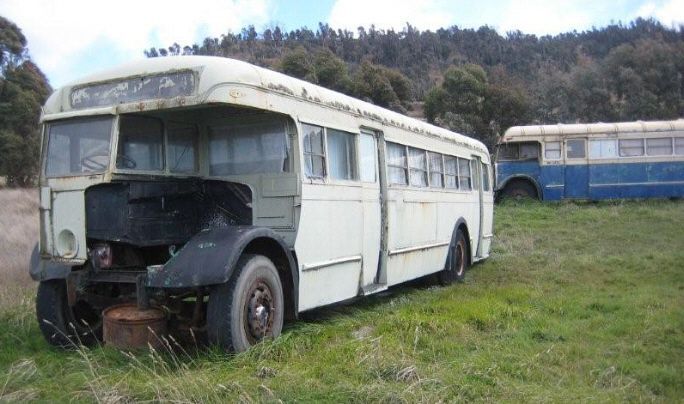
A call to Jeff Cooper of the Omeo Historical Society resulted in a really helpful response. Jeff said; "The two buses you mention are two of 22 that were bought from the Melbourne Tramway Dept in about 1975 by Ian Stapleton when he was setting up Mittagundi, which is a camp for kids to get back to nature: www.mittagundi.org.au."
"I believe one of the buses still resides there. When Ian got them, they had the engines and gearboxes removed, so he had to tow them the 500 kms to Omeo. He told me that he had to sell four of them en-route to pay for the transport fines he got. There are still a few around; I had one myself until it was destroyed in the 2003 bush fires, as were a number of others. In Ian's book (Something Small the story of Mittagundi) there are photos of the buses being towed through the snow."
"They were all AECs and, as per your website, some ended up in Western Australia. The two in question are used by fishermen in the trout season."
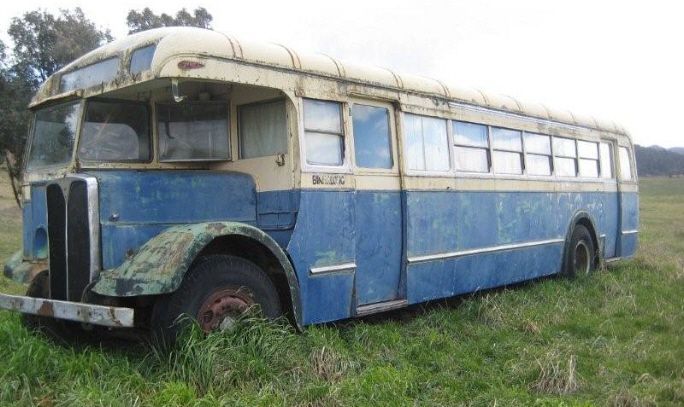
Jeff then proceeded to get a friend to photograph them, and you see the results here. Thanks very much to everyone who helped in this research, and if anyone can actually identify the exact vehicles, that would be the cherry on the cake!
SOME ROUTEMASTERS JUST KEEP ON GOING....
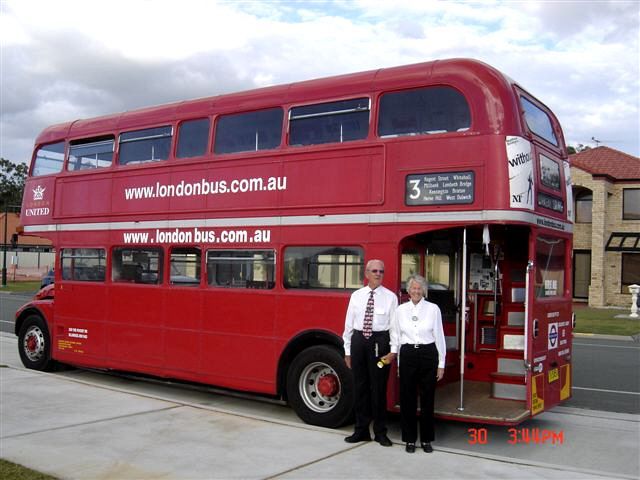
Derek and Jenny Jones sent the above picture in January 2010. They say "This is a picture taken in Queensland, Australia, just before we (pictured) took the bus to Brisbane to carry 60 students to a formal. This bus is based in New South Wales".
Ex London Transport and London United RML2353 (now named Betty) came to Australia in 2006 and is based at Billinudgel, New South Wales. Operator Andrew Mudie and his team say on their website http://www.londonbus.com.au that they think it's the only London bus in Australia. Well, that's not the case, but it's a good one nonetheless.
Most remarkable is that the owners intended to bring the bus BACK TO the U. K. for the 2012 Olympics! (Did it do that trip?) Read all about it on the website. Many thanks to Derek and Jenny for the photo.
RARE COMMER COMMANDO TURNS UP
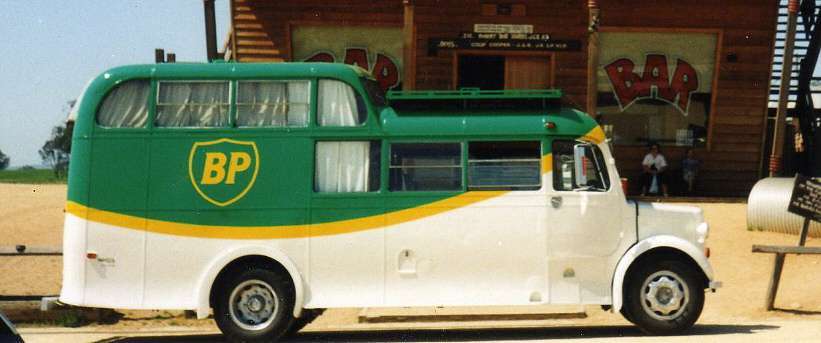
Darren Symonds emailed to say "Look what we have in Australia. We have been getting the bus ready for its normal once a year outing. We take the bus to the Bathurst 1000 (a 1000 km car race around public roads up and down a mountain every year); its first trip to Bathurst was in 1988. A lot has changed with the old girl in that time. It is over 700km from home for us, and takes us just over 8 hours to get there from our home town of Seymour, Victoria."
So what is it? Well this is a rare survivor of about 300 Commer Commandos, built in 1946/47 with Park Royal one and a half decker 20-seat coach bodies. They were often referred to as observation coaches, but in fact the design had nothing to do with the view, but was intended to provide a large rear luggage compartment under the raised seating at the back. This was because the vehicles were built to carry air passengers or crews to and from aircraft or passenger terminals, and they needed a lot of baggage space. They were made to a British government order, and supplied to four customers, the Royal Air Force (RAF), British European Airways (BEA), British Overseas Airways Corporation (BOAC), and the Ministry of Supply (MoS) who issued them to a variety of industrial facilities such as aircraft manufacturers and government facilities. Only about 6 survive - this one, another one in Canada, and four in the U. K.
Darren says that when his mate Peter Sanderson bought it, it was in a paddock in a bad condition, as seen below, so they've done a great job! It now has a dual-fuel Chrysler V8 engine and an auto box, instead of the original Commer 4-cylinder petrol, and the BP paint scheme was added in 1992.
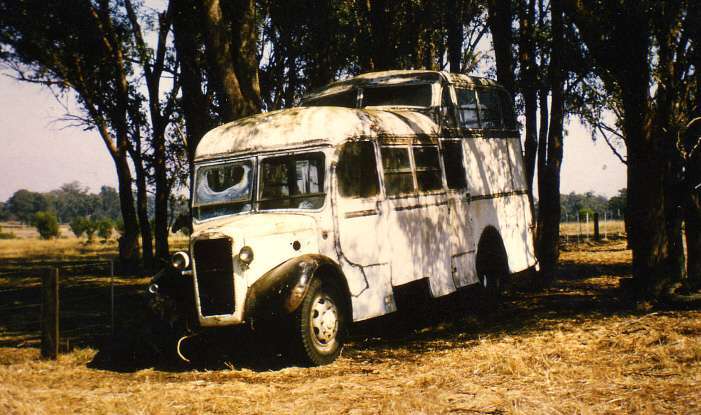
Darren says that he understands the bus was used by Australian National Airways (A. N. A.), who were later bought by Ansett, and then the bus passed to the St John's Ambulance in Seymour in the 1970s. So I guessed that it might have been brought to Australia by BOAC, and acquired by ANA when BOAC retired it (20 seats would soon have become a bit too small for international flights). Anyway Darren and his mate Peter have so far been unable to find a chassis or body number, so it's not possible to identify exactly which bus this is, but it's great to see it up and running, and my thanks to Darren for telling me all about it.
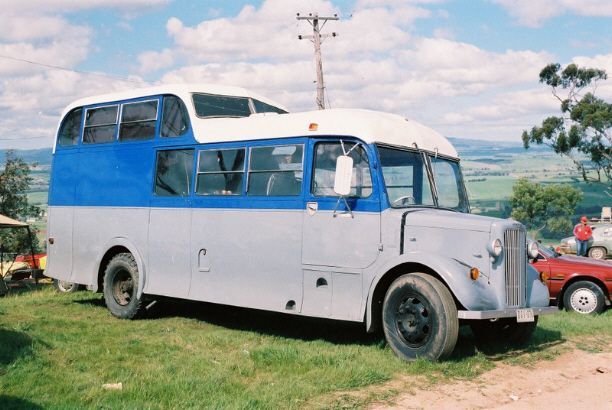
And then, in May 2011, Mike Cornwall sent the picture above. He took it in Bathurst (NSW) in 1988 - the first year that bus was there. Many thanks for that Mike, another piece of the story. All we need now is a picture of it when serving with BOAC or ANA!
But there's more! In June 2017 James Zegir emailed to say "The bus belonged to my father (Les Zegir) from about 1976 to the mid to late eighties. Indeed it was with the St John Ambulance, as I can recall the black cross emblem painted on the roof above the windscreen, about 12 x 12 inches in size. For whatever reason St Johns disposed of it to Rudy's Wreckers in Seymour (Victoria) and my father, a mechanic, purchased it with the intention of converting it into a motor home. It was towed to the rear of 41 Loco Street, Seymour, where my father managed to get it started and set about doing the conversion."
"Later, about 1979 when my father purchased a farm on Highlands Road, Seymour, it was towed there and sat in a paddock where my father used the expansive trunk (boot) as a storage shed for tools. I believe a person drove by our farm, saw it and made an offer to my dad and towed it away. The photo of it under the trees would have been in the period after my dad owned it." Thank you James. Another piece of the jigsaw.
FURTHER UPDATE!
Andy Reed kindly emailed me in Feb 2019 to say that he had come across a 1/76 model of an Australian National Airways Commando, made by Oxford Die-cast. Here's a link to it. On that page you will see that there is also a link to an original picture of the vehicle in ANA livery, and that has revealed more information about it.
The picture was posted on Flickr by Alan Farrow. Alan says that there were originally six of these, bought new by ANA in 1947. So the Commando featured in this item must have been one of those six. It looks to have a standard Park Royal body, but I can't find any mention of ANA either in the Park Royal body or Commer Commando chasis production lists. But I won't give up! Thanks very much to Andy for finding another piece in the jigsaw.
PRESERVED MELBOURNE REGAL
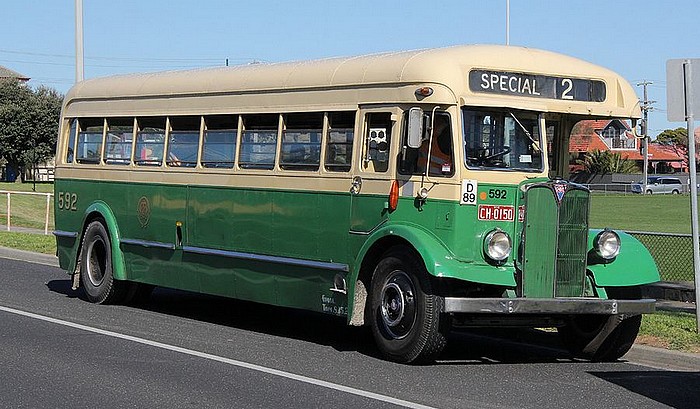
This fine M and MTB AEC Regal III belongs to John Phillips, and is seen at the Sandown Rally, Sandown Park, near Melbourne in 2007. Melbourne acquired a huge number of Regals in the early 1950s. Correct me if I'm wrong, but I reckon they had 18 with ComEng bodies in 1951-52 (no. 435 is believed to survive from this batch), 18 more with ComEng bodies in 1952 (352 survives at the Sydney Bus Museum), 29 with ComEng bodies in 1952-53 (513 survives as a mobile home), one with an Ansair body in 1953, and 69 with Martin and King bodies delivered in 1953-54. Of that last lot, 537 survives at the Tramway Museum Society of Victoria, and this one (no. 592) makes two. Many thanks to Pete Kane for letting me use this photo. Pete says "the AEC virtually still looks the same as when it came out of service, the owner John Phillips takes pretty good care of it."
MTT WORLDMASTER
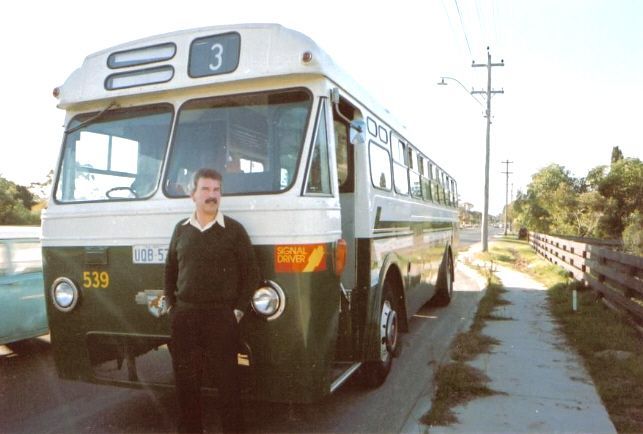
Mike Tamkin, now with Alpha Bus Co., has sent this photo from the late 70s/early 80s when he was a bus driver with the MTT at Causeway depot, Perth. It shows no. 539, one of a batch of 20 Leyland Royal Tiger Worldmasters delivered in 1963. Mike says "We had about 40 like this at Causeway depot as late as 1980". Thanks Mike.
BRISBANE REGAL SWAPPED FOR A COW
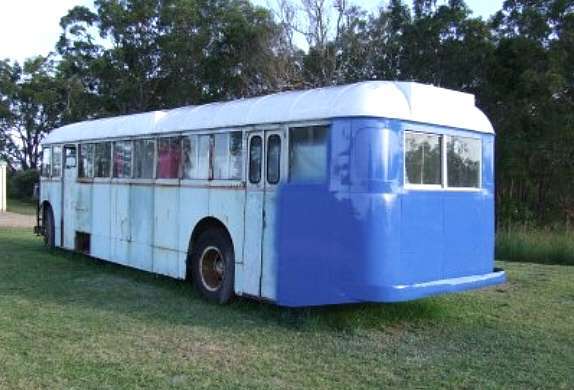
Doug Whale, from Queensland says "We have an AEC Regal III from 1948 with 9.6 ltr diesel and 4 speed preselect gearbox. Body was built by Commonwealth Body Builders In Sydney. This bus is one of only three surviving in Australia. The other two are owned by members of QOCS. We are still in restoration stage. May take quite some time as we are trying to find parts to get it running again."
"These buses were owned and operated by Brisbane City Council, from 1949-50 until 1971 when this particular bus, no. 78 was decommissioned and eventually sold in 1973 to a chap that lived in Brisbane and actually drove this same bus for the council during those years. He was going to transform it into a motorhome but never got that far, having passed away and left it to his son, who at the time was driving taxis for the same council. The bus sat in their backyard, (or rather their paddock) for nearly 16 years, never being moved or started, until the son moved to Gympie and set up house here in 1989."
"He also thought about building it into a motorhome for the next 12 years and gave up on the idea after moving back to Newcastle, (just north of Sydney) to take up driving coaches up the Hunter Valley. The bus was then given to a mutual friend of ours as a storage shed for his computer gear, and sat in his yard for another 4 years until I saw it and purchased it for the price of a Jersey milking cow ( I swapped him a cow for it ) on 5 Oct 2006."
"Since 1973 it has not been started but has been turned over, apparently burning out the starter motor, (they tried to start it on 12 volts). It still has 26 gallons of diesel in the fuel tank from 1973. I am still looking for a starter motor for it, so I can get it running...ANY HELP would be appreciated !!
"The bodies for these buses were made by Commonwealth Engineering in Granville, Sydney, and Athol Hedges in Brisbane (ours is a ComEng) between 1948-1953. I don't know exactly how many were made, but from research I have done, I think there were only 12 or 13 Regal IIIs with full fronts, others around the country I have seen are all half fronts."
Doug's bus is number 78 (chassis number O962261) but, as he says, no. 77 is preserved by the Heritage Bus Association, and no. 80 is with QOCS. Good luck with the restoration!
LEYLAND COMET SURVIVOR
Al Curran called to ask if I could identify this 1962 Leyland 33 foot bus. He said that the owner was turning it into a motorhome and Al was making his thermal curtains. He had asked Al if he could identify the model, and he had looked for hours through bus websites without success.
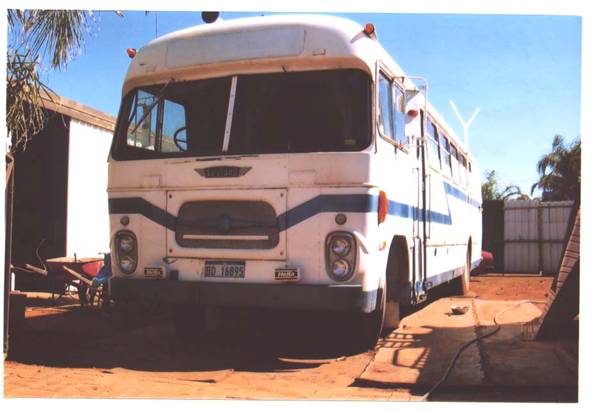
I was still struggling with that when Al got a response from elsewhere solving the problem.
Ian Lynas wrote "It is almost certainly a Leyland Comet with a Cycle Components Manufacturing Co. body (CCMC) (pre Customs days), and I would hazard a guess it is ex-Delwood Bus Co., or one of the Rowe group of companies, Campbelltown Transit or Parramatta-Villawood. It should have a chassis number on the offside about mid way along the chassis or the same place on the nearside. Difference is some were original Comets rebodied or they were chassis intended for export to places like India or South Africa and they got diverted to Australia. It should also have a body number on the CCMC plate around the middle of the plate starting with the year suffix 58/??? through to the mid 1960s."
Ian attached an old photo of a similar looking bus at Campbelltown, to prove his point. Interesting find!
LONDON RT ENJOYS THE SUNSHINE
Paul Harrington from Morphett Vale, South Australia, wrote: "allow me first to say what a superb website you've put together on the subject of classic buses. Simply brilliant. I've enjoyed surfing through it many times. The main reason I've put finger to keyboard is to inform you of an immaculate RT series bus currently being used in South Australia."
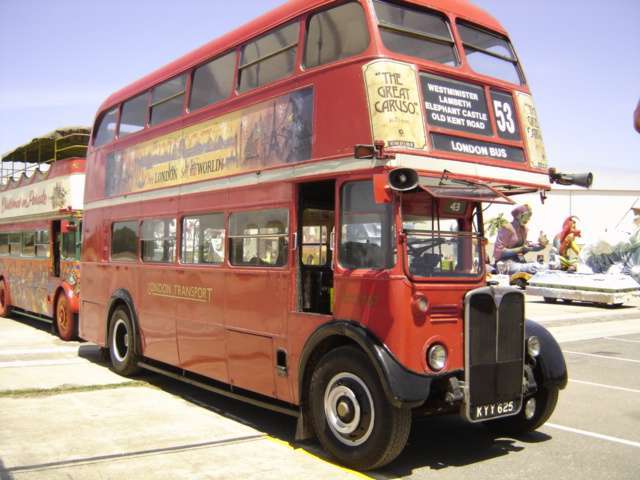
"I drive RT 1787(KYY 625) only once a year on South Australian roads for the annual Christmas pageant. Unfortunately I'm not the owner, as it's owned by South Australian Major Events Commission. But sometime in the future... who knows."
Thanks Paul. I love the loudspeakers on the front, which I think were not standard when in London service ! The activity in the background is also interesting - not just the other RT behind with red wheels and scalloped sidewalls, but what on earth is happening on the right of the picture?
Well, Scott Mitchell emailed to provide the answer. He says; "The happenings behind the RT are the setting up of the Christmas pageant floats. A long tradition in Adelaide was to go see the Christmas pageant with the family. There are many floats all based on children's stories. As for the RTs, I have a few pics of them in the pageant and I even got to ride on 1787 one year after the pageant to get some photos."
Thanks Scott. That explains it.
SYDNEY REGENT HEADS FOR RESTORATION DOWN AT THE PUB
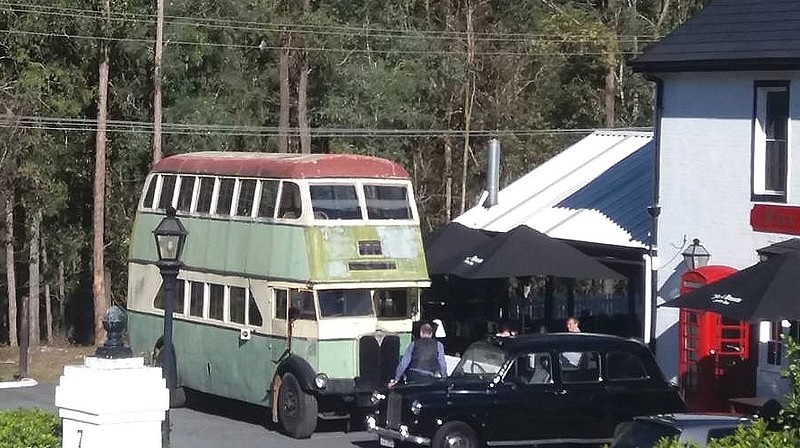
Mat Foster normally sends me photos from New Zealand, but in June 2017 he sent me this picture (taken in August 2016) from Australia for a change. Mat says "This bus used to run around the Gold Coast. It's in a pretty bad state but was going away to have a full restoration and be used as a team tour bus on the Sunshine and Gold Coasts. The couple that own it also have an English pub."
And so they do - The Fox and Hounds Country Inn at Wongawallan, Queensland, which claims to be the only English pub on the Gold Coast. They have real English beer and their menu includes Toad in the Hole and Yorkshire Pudding! Thanks for the news, Mat. Anybody know which Sydney Regent it is?
Well of course Ian Lynas knows which one it is! He wrote in April 2020 with the following details and photos:
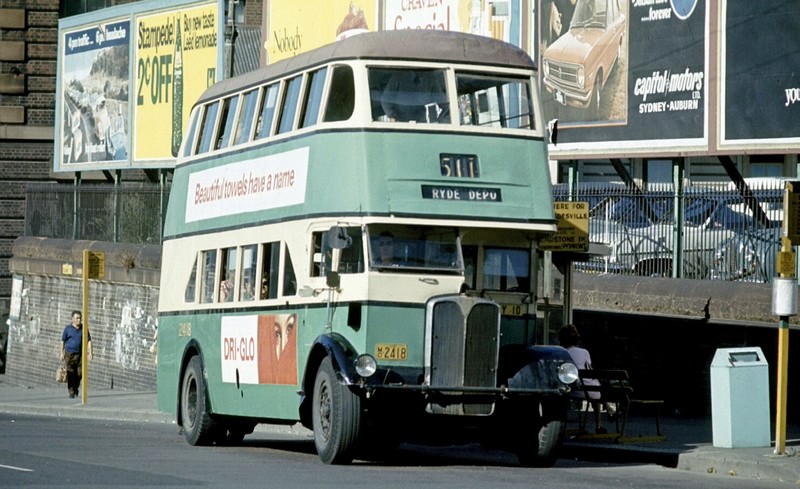
"This is an AEC Regent III with Commonwealth Engineering body and was 2418 with the DGT in Sydney. The picture above shows it in service in Sydney on 23 February 1972 in rather faded condition working from Ryde depot. The hand indicator can just be seen, between the bottom of the driver's window and the first sloping window of the passenger saloon. Motorists seemed to have more respect for the hand than for electric flashers."
"There is no evidence that it was ever on the Gold Coast, although there were other ex-Sydney AEC Regents doing tourist work. 2418 was disposed of by the DGT in 1972 to Goulburn Bus Service, in south central NSW and by 1980 was in the town of Batemans Bay on the coast, going to Macquarie Towns Bus Service at Windsor in north-western Sydney by 1982, where the employees began a restoration project to get the bus back to original condition."
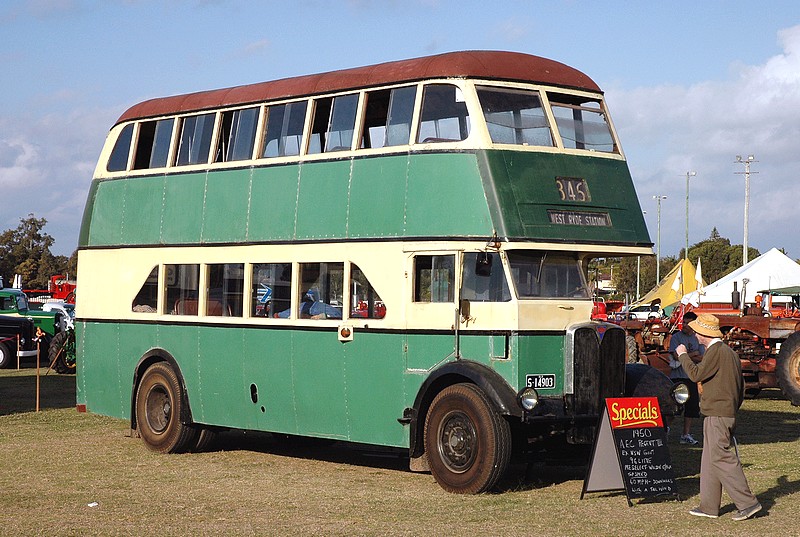
"It had been acquired by a John Freeman by 2002 and was part of the Heritage Bus Association by 2004. It appeared at various historic vehicle rallies in the 2000s and is shown above at the Cleveland Historic Vehicle Show (east of Brisbane, Queensland) in August 2006. By this time it was on Queensland Historic plate S.14903 and had been repainted in a far darker shade than it had originally."
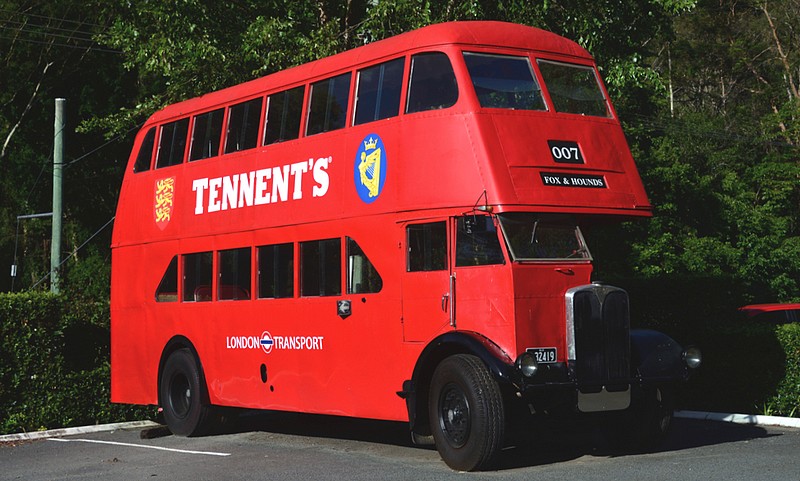
"The bus arrived at the Fox and Hounds around the end of the decade and was in a dilapidated state for quite some time until a real start was made in 2016. By 2018 the bus had been repainted in all-over rich red livery and advertised Tennents lager. The hotel is now owned by Justin Hemer and the bus has now been issued with Historic registration S.32419. The photo shows 2418 on 30 December 2018 at the Fox and Hounds Country Inn with new plate S.32419 and now in this startling all-over red with the Tennent's advert." Thanks very much Ian.
LEYLAND MOTORHOME
Zach Thomas emailed me an advert for his 1957 Leyland double decker bus motorhome-conversion for sale. At the time it was stored at Aldinga in South Australia, about 1 hour south of Adelaide.
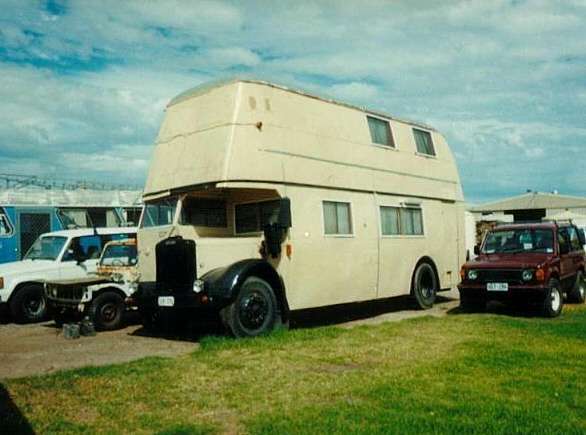
We tried to identify it, but Zach was unable to find a chassis number. I'm guessing it's a Sydney Leyland Titan OPD2, but maybe somebody can throw some more light on it. (David Wilson says it's an OPD2/1 with a Clyde body).
Zach had been trying to sell it for some time, without success, and the last I heard he had decided that part-exchanging it for a car was the only way he was going be able to pass it on!
Email Events diary Past events list Classified adverts Classic U.K. Buses Classic Irish Buses Classic Manx Buses